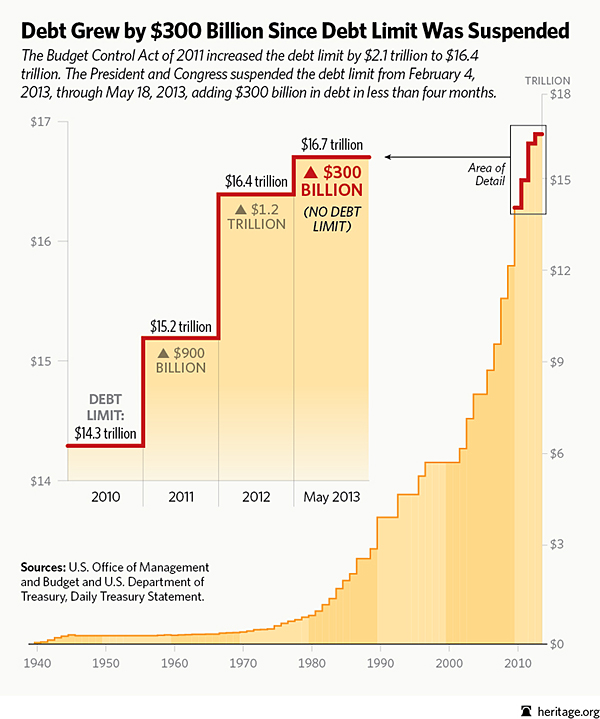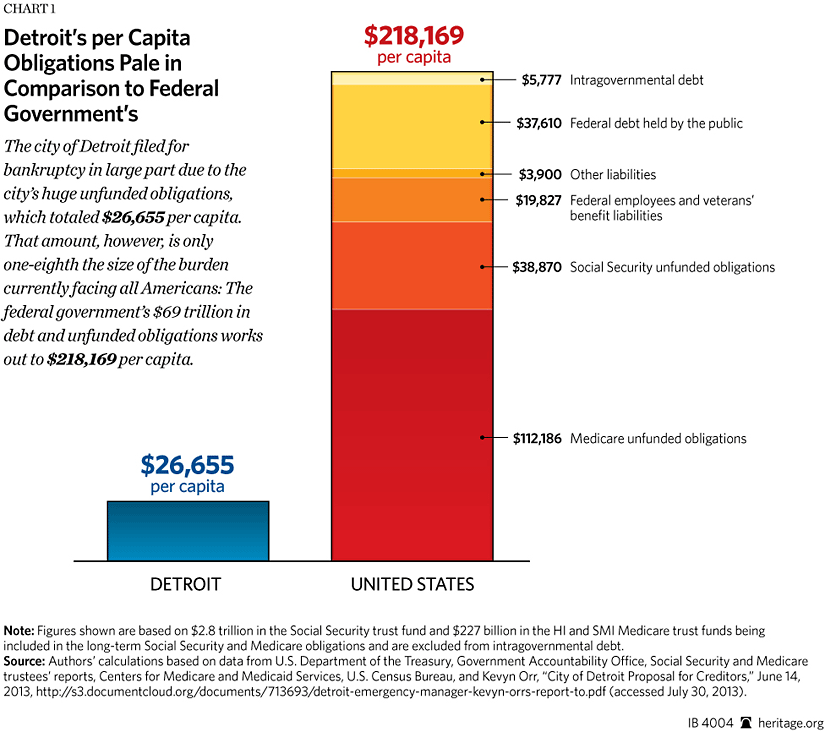
Happy U.S. Credit Rating Downgrade Day! Two years ago today, Standard & Poor’s downgraded the U.S. credit rating and, not surprisingly, it hasn’t recovered since. Despite 2012 campaign rhetoric and the liberal-media narrative, the downgrade occurred because the President and Congress failed to resolve the long-term spending and debt crisis. Within that time period, the President has failed to lead, hasn’t proposed any significant reforms, and the situation is even worse.
As suggested by Heritage today, again, Congress and the President should rein in out-of-control spending and reform the entitlements before, or as part of, any increase in the debt ceiling this fall.
What the Republican Party has done a miserable job at explaining to the average American voter, is that a lesser credit rating means investors will inevitably require a higher interest rate to purchase U.S. government debt. A higher borrowing cost for the U.S. government would drive the cost of spending even higher and exacerbate our already deeply troubling deficit and debt situation. Then, you can forget all about Social Security, Medicaid, or even emergency food stamps, because there just won’t be enough in the foreseeable budget for investors to take the risk.
In the end, the very people progressivism claims to help are the ones who are hurt the most.
The Budget Control Act’s approach—to offset any increase in the debt ceiling with spending reductions of equal size—was a workable compromise at the time and contained a slight chance of arriving at entitlement reforms through a so-called supercommittee.
The supercommittee – what Newt Gingrich called the “stupidest idea in the history of Washington” – was a 12-member panel evenly divided between Democrats and Republicans charged with the task of compromising over $1.2 trillion in spending reductions—or else the dreaded “sequester” would kick in. Though the Budget Control Act allows spending and debt to continue to grow indefinitely, it at least forced some semblance of fiscal discipline.
Even though the media and the President threatened that the sky would fall if we didn’t avoid the sequester, the Budget Control Act did nowhere near enough, and the supercommittee was a failure, ultimately. The act reduces only one-third of the U.S. federal budget through discretionary spending, which includes defense and non-defense programs. Yet the spending cuts were are poorly targeted and were set up in such a way as to ensure endless political conflict in Congress. They threaten the nation’s defense capabilities the most, which some conservative groups are unwilling to compromise over.
Meanwhile, the key drivers of out-of-control spending and growing debt continue expanding rapidly: Medicare, Medicaid, and Social Security already consume 45% of the budget and are growing fast with no end in sight. In fact, Obamacare accelerates the entitlement spending explosion. The Budget Control Act leaves these problematic programs nearly untouched, certainly without reform, and keeping the U.S. on a path to fiscal crisis and insolvency.
When Standard & Poor’s downgraded the U.S. credit rating in 2011, the ratings agency clearly stated that the deficit-reduction measure Congress and the President agreed upon fell far short of anything up to correcting the U.S. fiscal course. Moody’s, another big-three ratings agency (Fitch Group is the third), warned recently that further fiscal consolidation was necessary to avoid deficits growing too big again in the future, which could hurt the U.S. rating. Egon Jones, as well, downgraded in short order a few months later.
Today marks the second anniversary of the U.S. credit downgrade by S&P of a rating the U.S. had held for 70 years, and our nation’s spending and debt problem has only gotten worse. The U.S. hit its statutory debt ceiling in May with a debt that’s bigger than the entire U.S. GDP at $16.7 trillion. Treasury is borrowing from accounts that are not subject to the debt limit to continue spending that exceeds revenues, but that headroom will likely run out sometime this fall.

Fixing the national debt is ultimately a state problem as well, which when taken into context, properly underscores the depth to the threat that is progressivism. In the next article we will look further into the Detroit bankruptcy, how it will affect the national debt crisis, and who may be next after the city that was once referred to as the “Arsenal of Democracy.”
In the meantime, Happy U.S. Credit Rating Downgrade Day!







